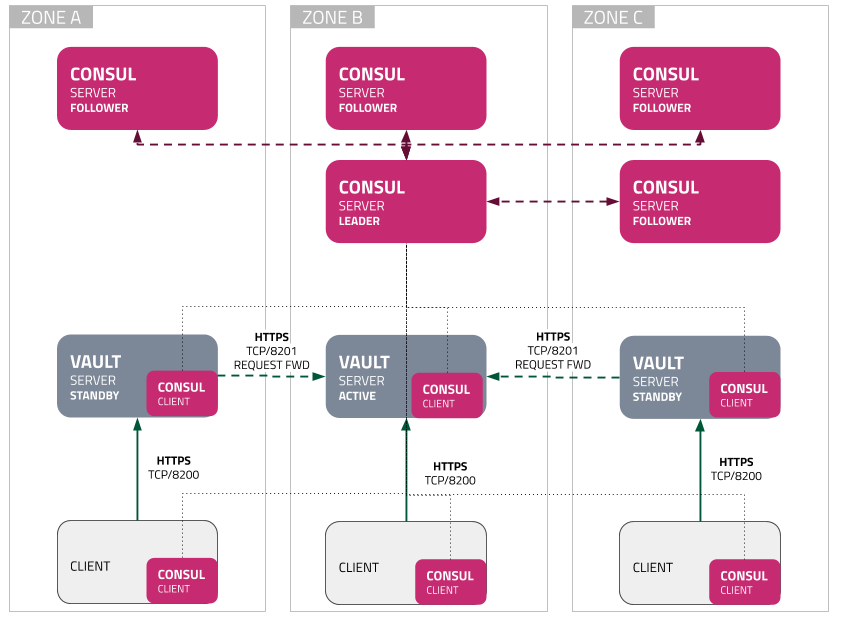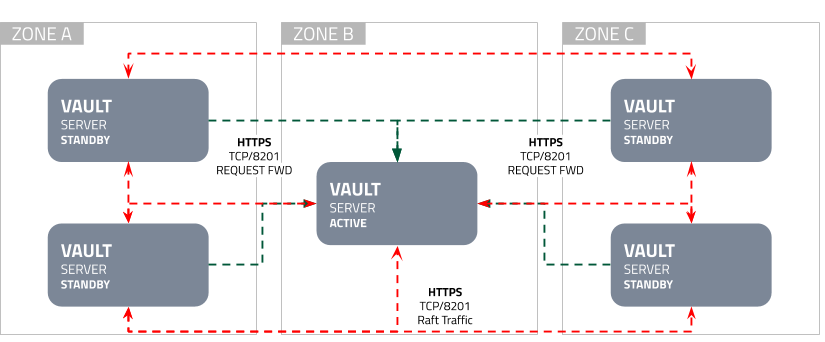Vault
Migration checklist
This is a decision-making checklist
The purpose of this checklist is not to walk you through the storage migration steps. This content provides a quick self-check whether it is your best interest to migrate your Vault storage from an external system to Integrated Storage.
Who should use this checklist?
Integrated Storage is a recommended storage option, made available in Vault 1.4. Vault continues to also support other storage solutions like Consul.
You should use this checklist if you are operating a Vault deployment backed by external storage like Consul, and you are considering migration to Integrated Storage.
Understand architectural differences
It is important that you understand the differences between operating Vault with external storage and operating with Integrated Storage. The following sections detail key differences in architecture between Vault with Consul storage, and Vault with Integrated Storage to help inform your decision.
Reference architecture with Consul
The recommended number of Vault instances is 3 in a cluster which connects to a Consul cluster which may have 5 or more nodes as shown in the diagram.
A total of 8 virtual machines hosts this Vault highly available architecture.

The processing requirements depend on the encryption and messaging workloads. Memory requirements are dependant on the total size of secrets stored in memory. The Vault server itself has minimal storage requirements, but the Consul nodes should have a high-performance physical storage system.
Reference architecture with Integrated Storage
The recommended number of Vault instances is 5 in a cluster. In a single HA cluster, all Vault nodes share the data while an active node holds the lock; therefore, only the active node has write access. To achieve n-2 redundancy, (meaning that the cluster can still function after losing 2 nodes), an ideal size for a Vault HA cluster is 5 nodes.
More deployment details in the documentation
Refer to the Integrated Storage documentation for more deployment details.

Because the data gets persisted on the same host, the Vault server should be hosted on a relatively high-performance hard disk system.
Consul vs. Integrated Storage
The Integrated Storage eliminates the need for external storage; therefore, Vault is the only software you need to stand up a cluster. This indicates that the host machine must have disk capacity in an amount equal or greater to that of the existing external storage backend.
System requirements comparison
The fundamental difference between Vault's Integrated Storage and Consul is that the Integrated Storage stores everything on disk while Consul KV stores everything in its memory which impacts the host's RAM.
Machine sizes for Vault - Consul as its storage backend
It is recommended to avoid hosting Consul on an instance with burstable CPU.
| Size | CPU | Memory | Disk | Typical Cloud Instance Types |
|---|---|---|---|---|
| Small | 2 core | 4-8 GB RAM | 25 GB | AWS: m5.large |
| Azure: Standard_D2_v3 | ||||
| GCE: n1-standard-2, n1-standard-4 | ||||
| Large | 4-8 core | 16-32 GB RAM | 50 GB | AWS: m5.xlarge, m5.2xlarge |
| Azure: Standard_D4_v3, Standard_D8_v3 | ||||
| GCE: n1-standard-8, n1-standard-16 |
Machine sizes for Vault with Integrated Storage
| Size | CPU | Memory | Disk | Typical Cloud Instance Types |
|---|---|---|---|---|
| Small | 2 core | 8-16 GB RAM | 100 GB | AWS: m5.large, m5.xlarge |
| Azure: Standard_D2_v3, Standard_D4_v3 | ||||
| GCE: n2-standard-2, n2-standard-4 | ||||
| Large | 4-8 core | 32-64 GB RAM | 200 GB | AWS: m5.2xlarge, m5.4xlarge |
| Azure: Standard_D8_v3, Standard_D16_v3 | ||||
| GCE: n2-standard-8, n2-standard-16 |
If many secrets are being generated or rotated frequently, this information will need to be flushed to the disk often. Therefore, the infrastructure should have a relatively high-performance hard disk system when using the integrated storage.
A note about the importance of IOPS
Vault's Integrated Storage is disk-bound; therefore, care should be taken when planning storage volume size and performance. For cloud providers, IOPS can be dependent on volume size and/or provisioned IOPS. It is recommended to provision IOPS and avoid burstable IOPS. Monitoring of IOPS performance should be implemented in order to tune the storage volume to the IOPS load.
Performance considerations
Because Consul KV is memory-bound, it is necessary to take a snapshot frequently. However, Vault's Integrated Storage persists everything on the disk which eliminates the need for such frequent snapshot operations. Take snapshots to back up the data so that you can restore them in case of data loss. This reduces the performance cost introduced by the frequent snapshot operations.
In considering disk performance, since Vault data changes are immediately written to disk, rather than in batched snapshots as Consul does, it is important to monitor IOPS as well as disk queues to limit storage bottlenecks.
Inspect Vault data
Inspection of Vault data differs considerably from the consul kv commands used
to inspect Consul's KV store.
Consult the Inspect Data in Integrated Storage
tutorial to learn more about querying Integrated Storage data.
Summary
The table below highlights the differences between Consul and integrated storage.
| Consideration | Consul as storage backend | Vault Integrated Storage |
|---|---|---|
| System requirement | Memory optimized machine | Storage optimized high IOPS machine |
| Data snapshot | Frequent snapshots | Normal data backup strategy |
| Snapshot automation | Snapshot agent (Consul Enterprise only) | Automatic snapshot (Vault Enterprise v1.6.0 and later) |
| Data inspection | Online, use consul kv command | Offline, requires using recovery mode |
| Autopilot | Supported | Supported (Vault 1.7.0 and later) |
Self-check questions
- Where is the product expertise?
- Do you already have Consul expertise?
- Are you concerned about lack of Consul knowledge?
- Do you experience any technical issues with Consul?
- What motivates the data migration from the current storage to Integrated Storage?
- Reduce the operational overhead?
- Reduce the number of machines to run?
- Reduce the cloud infrastructure cost?
- Do you have a staging environment where you can run production loads and verify that everything works as you expect?
- Have you thought through the storage backup process or workflow after migrating to the Integrated Storage?
- Do you currently rely heavily on using Consul to inspect Vault data?
Tutorials
If you are ready to migrate the current storage backend to Integrated Storage, refer to the Storage Migration Tutorial - Consul to Integrated Storage.
To deploy a new cluster with Integrated Storage, refer to the Vault HA Cluster with Integrated Storage tutorial.